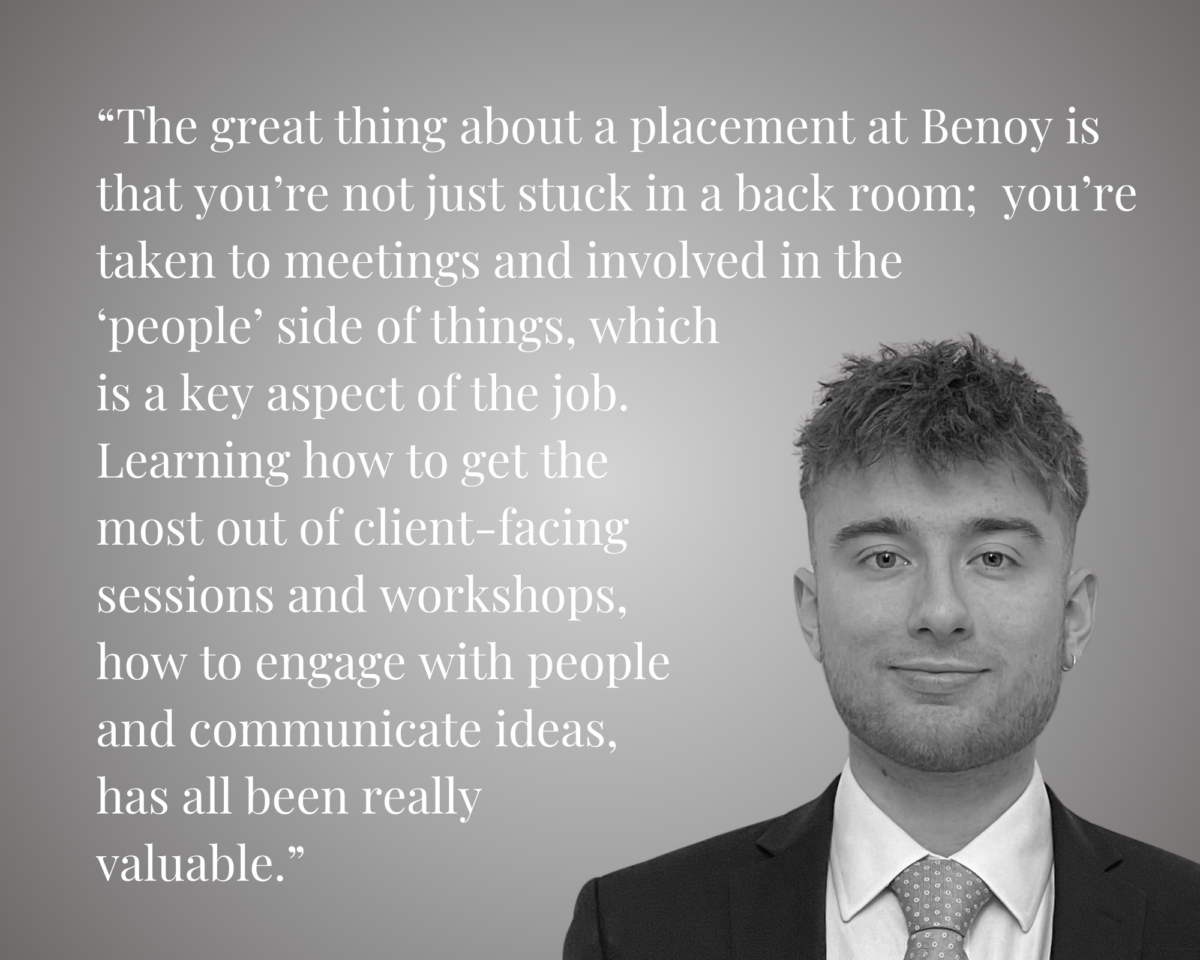Benjamin Tarver is a Part 1 Architectural Assistant in our London studio. Here, he discusses combining his Masters study with his industry placement at Benoy, reflecting on what he’s learned and where he wants to go.
Return to Future ThinkingReflections on Part 1 life at Benoy - Balancing the macro and the micro
Where are you in your architecture journey, and what have you been working on since you joined Benoy?
I’m an MAarch student in my fourth year at Cardiff University. It’s a designated ‘learning-in-industry’ year, and I’ve been on placement with Benoy since October 2023. I’ll be here until late September 2024, when I’ll return to Cardiff to finish my Masters.
During my time at Benoy, I’ve been mainly involved in projects in the Middle East – Saudi Arabia in particular. I’ve been doing a lot of early stage design and conceptual work for large hospitality and commercial projects, but also some masterplanning. I wouldn’t normally get involved in masterplan concepts, so this has been really interesting. I’ve enjoyed balancing the macro and the micro; taking a big picture view of mass and layout, assessing the commercial implications of key planning features, then diving into the niche architectural zones and detail.

What skills and experiences have you acquired this year?
When I arrived at Benoy, I realised that the design software I was familiar with isn’t really used professionally anymore. So I had to adopt new tools, specifically Rhino, Revit and a visual programming plug-in called Grasshopper, all of which required new knowledge and skills. But thankfully my colleagues were really patient and generous with their time, helping me understand how it all works. I put in the hours to fast-track my learning, which meant I could begin to use these tools with confidence.
While much of my work has been software-based, I’ve also gained a lot of experience of client interaction, which has been fascinating. The great thing about a placement at Benoy is that you’re not just stuck in a back room; you’re taken to meetings and involved in the ‘people’ side of things, which is a key aspect of the job. Learning how to get the most out of client-facing sessions and workshops, how to engage with people and communicate ideas, has all been really valuable.
The geographical focus of the work has also been a completely new experience. Previously, all my university projects had been based in Wales. So adopting an international outlook has been a real eyeopener. The early stage design work I’ve been doing in the Middle East has been great fun – conceptual and experimental, but also highly technical. Designing for hot climates has also been really interesting, as I’m into sustainable design in a big way. With projects in the Middle East, we do a lot environmental analysis, looking at exposure to sun and wind, devising shading strategies and efficiency measures. How do we deliver sustainable outcomes through passive design? How do we embed passive features into buildings before we consider the use of technology? These are key questions we’re constantly asking.
How will these experiences help you in your studies and beyond?
From a practical perspective, it’s good to know I’ve got the most up-to-date early stage design software under my belt. I feel very secure with those skills now, and I look forward to applying them to my Masters work next year. More generally, understanding the importance of a coherent and legible design package as a tool for communication – that’s something I’ll definitely take with me. When you’re at university, you don’t see your work getting marked or witness the process of grade allocation. Through my time at Benoy, having been involved in design meetings and client presentations, I’ve gained insight into how design packages are interpreted and evaluated, which has helped me to refine my own work and approach.
Above all, this experience has helped me see that business architecture is the direction I want to take. Talking with Benoy’s sister company, Pragma, I’ve realised how much I enjoy the strategy and data behind the design. I really like getting involved in the analytics that shape key design decisions; the interaction with the client to explain footfall, consumer trends and behaviours, and how these things influence design outcomes. Looking at floor area ratios and calculations, the numbers that determine whether or not a product is successful – that kind of thing intrigues me, and this experience has opened my mind to this area of study and practice.
What originally inspired you to get into architecture?
I always loved maths, numbers and technology at school, while also feeling the pull of creative subjects. And then, when I was in sixth form, I did a placement in a sustainable architecture firm, which I loved. So it was a combination of that early exposure, plus a realisation that architecture was a discipline where I could put all those interests – creativity, tech, maths – into one; where I could solve problems and design at the same time. That’s how I knew this was the profession for me.
Sustainability has always been something I’ve wanted to pursue, and sustainable design is such a massive thing in architecture today. I often think we don’t really define design periods – like Art Deco or Postmodernism – until they’re over. I think we’re in the middle of the ‘sustainability design period’ right now; and it’s only going to get bigger, more urgent. So it’s exciting to be a part of that.
Do you have any advice for architecture students looking for a placement?
Firstly, I would say don’t limit yourself too soon. While it’s good to specialise, as a Part 1 you need to experiment and sample different disciplines and pathways. It’s really important to get a taste of everything, which I’ve had the opportunity to do at Benoy: early and late-stage design, technical and conceptual, masterplanning – working across retail, residential, hospitality and commercial. It’s been really fun, but it’s also helped me understand what it is I want to do. So, try lots of things; experiment before you find your niche.
Also, don’t fear your first job. You’re naturally nervous starting a placement, but everyone here has been so nice and welcoming, and so willing to share their time and knowledge with me. So don’t be afraid, and don’t be shy to tap into the expertise of others.

